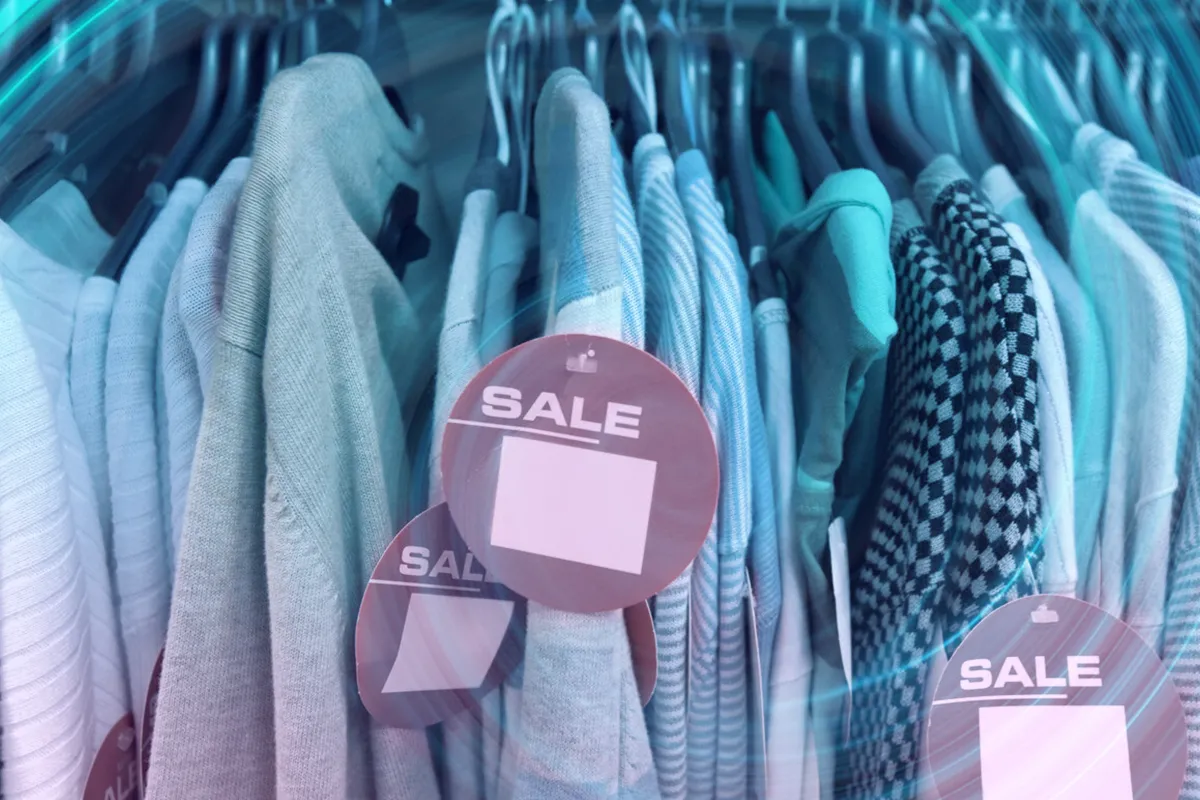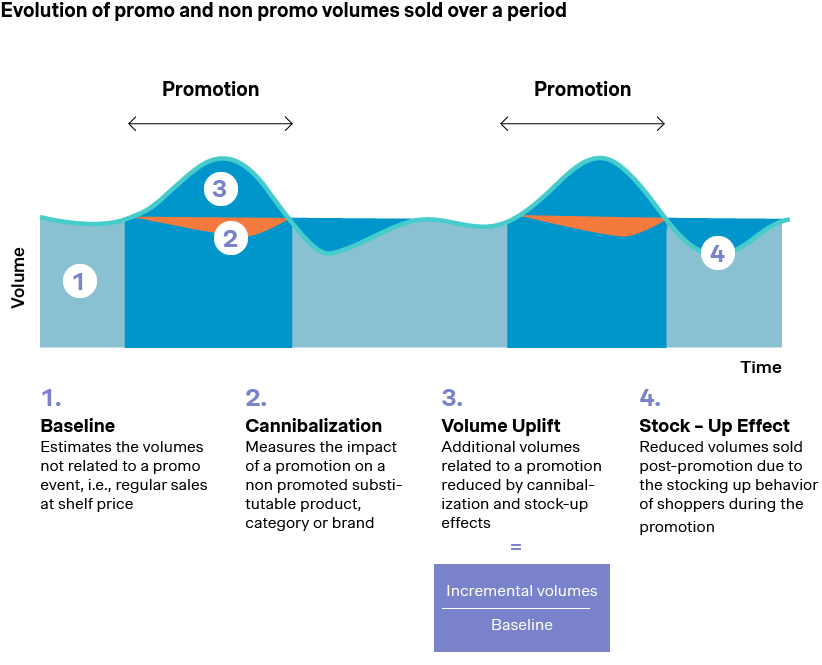Perfect your promotion for revenue growth
The current retail environment is demanding. Promotion budgets are expanding annually, promising foot traffic and loyalty. However, for brand manufacturers, this comes with a diminishing return on investment, exacerbated by a saturated market where each promotion’s impact lessens as costs rise. Those that try to make improvements face resistance – both externally from retail partners and internally from their own teams.
Many brand manufacturers just want to maintain the status quo. But without continuous improvement in your promotion strategy, you jeopardize your competitiveness, profitability, and long-term sustainability.
We get it – optimizing promotional activities involves a tricky balance. Promotion strategy is a ground where every brand must tread carefully.
The challenges with promotion strategies
- The budget balancing act
Retailers are clamoring for a bigger slice of your promotional pie each year. Why? Because promotions are their golden ticket to foot traffic and customer loyalty.
- The ROI rollercoaster
Here’s the catch for brand manufacturers - every time you open your wallet for a promotion, the ROI high you’re chasing becomes a bit more elusive due to market saturation. The more promos running, the less impact each one makes. Meanwhile, simple calculations and an unclear baseline neglect important effects that influence your ROI.
- Multi-brands, multi-challenges
One brand is simple. But throw in multiple brands, categories, products, and retailers into the mix, and suddenly, your promotion strategy becomes a Rubik’s Cube. Where do you put your money to reach maximum impact, minimize cannibalization and ensure alignment with your global strategy?
- Siloed approach
Marketing has its grand plan, but the sales team gets a different script from the retailer. The chosen products do not always align with your bigger picture.
- Failed improvements
You may have tried optimizing before, and failed. Maybe the math was inaccurate, too complicated, your strategy was too transversal, there were too many factors to integrate, or you lacked the tools/data to tackle the challenge. This leaves hesitance to try anything new in the future.
- The copy-paste conundrum
Stuck in the copy-paste comfort zone? It feels safe to replicate what worked last year. But when everyone is doing the same, the safety net starts to wear thin.
When it comes to promotion strategy, success lies in the details. And at Simon-Kucher, understanding what makes promotions work is our bread and butter.
In this article, we share insights that can change the game for your promotion strategies.
Why are you running promotions in the first place?
That’s the first question to ask as you review your promotion strategy. Whether the goal of a promotion is generate volume or foster customer loyalty, you need to define the purpose and have a crystal-clear understanding of your objectives. Make sure everyone from marketing to sales and even the finance team is on the same page.
Promotions are not a one-size-fits-all affair, and you should tailor your approach based on your product and category objectives. For example, immediate rebates will work for new products where you want to gain customers. Buy One Get One Free offers will be more suitable for driving volumes. Select the right mechanism, the right type, and the right channel for the desired results.
Every dollar counts. The aim is to make sure each one is well-spent, which means promotions should not be left to random selection. Here, choosing the right product, retailer, and mechanism needs to be grounded in data analysis. Strong data will be key to convincing your internal stakeholders and initiating change.
How to calculate your ROI on promotions
The clear message to your teams is that it’s not just about doing promotions; it’s about doing them smarter. Before you can improve your strategy, you need to understand what works, what doesn’t, and why. Therefore, you need to assess your promotion performance, identifying the levers that turbocharge your promotion ROI.
The first step is to establish the baseline - the volume you would sell without any promotions.
Then pinpoint the starting and end dates of past promotions, looking at the total volume during this period. By subtracting the baseline, you understand the incremental volume gained from these promotions.
Many brand manufacturers already apply this straightforward calculation. However, this overlooks other important effects that impact your volumes:
- The stock-up effect: The temporary reduction in consumption after a bulk purchase.
- Cannibalization: One product’s gain is often another product’s loss.
- Halo effect: A pleasant afterglow post-promotion. Some consumers remember your brand, they come back, and they become repeat customers.
Simon-Kucher’s robust methodology to calculate ROI
One size doesn’t fit all, especially when it comes to calculating ROI. At Simon-Kucher, our methodology is as unique as your brand. Depending on the effects you want to assess, whether it’s product-related, retailer-specific, channel-oriented, or time-sensitive, we tailor the calculation to suit your needs.
Your type of company, and your maturity in understanding promotion ROI, and your available data shape our approach. That’s why, instead of offering cookie-cutter solutions, we deliver a bespoke strategy.
But whatever the promotion excellence project, we always deliver the same level of sophistication when calculating ROI:
- We collect and combine data sources. We’re not afraid to get our hands dirty with data. From sell-in and sell-out data to promotional costs, we gather it all. This helps you see the full picture and reveals the true impact of your promotions.
- We customize the baseline calculation. For low promotional intensity markets, we craft a baseline based on a moving average, reflecting market trends and seasonality. In high-intensity markets, we explore multiple baseline options to tailor our approach to the unique market dynamics.
![]()
- We integrate promotional effects seamlessly into our calculations. We include cannibalization, stock-up, and halo effects to measure the impact on both your promoted and non-promoted substitutable products.
- We identify your most profitable promotions. Whether it’s ROI efficiency, volume efficiency, or the perfect marriage of both, we uncover the gems in your promotional mix.
We determine the promotions with positive ROI and the ones with positive uplifts and then combine both to showcase the sweet spot. By identifying top performers, we help you understand the winning features - brand, time of the year, promotion mechanism, and more. Developing these features in other promotions becomes your recipe for continued success.
- We also identify which promos need to go. Here, your strategy shapes the focus. In a well-established market, pure value generators may remain in the equation. Launching a new product? Seeking market share? Volume generators could still be your go-to strategy. But not every promotion is a winner. If it’s a value destroyer, it’s time to stop. Understanding how many events fall into this category and strategically reallocating that budget is key.
- We optimize promotion spend allocation
We compare the ROI of promotions and incremental value between retailers, challenging the current investment allocation. Your promotion budget should be a strategic powerhouse, and we make it so.
- We provide customized tools for ongoing improvement
Tools matter. Excel-based nightmares are not our style. We provide collaborative, shareable, and data-plugged PowerBI tools. Customized, down to your brand colors, These customized tools aren’t just for today; they’re your future promotion success. Baseline recalculations happen on a permanent basis, keeping you ahead of the curve.
- Wondering how you measure up? Our experts work with a vast network of brand manufacturers spanning global markets. We provide benchmarks across retailers, categories, countries, and your competitors.
Convincing retailers of your strategy
Once you have developed your new promotion strategy, you must ensure it hits the ground running. Therefore, it’s crucial to fully transfer your concepts, tools, and methodologies to the sales team. Sales require guidelines, concrete plans per retailer, and negotiation training to ensure a smooth transition.
Proposing something that is not aligned with the retailer’s interest is a quick route to rejection. Retailers have their favorites – the blockbusters that they can feature in their leaflets and draw in the crowds. However, you now know it’s not a simple game of promoting what’s already popular. While blockbusters have their place, you may be considering more innovative, niche products that bring a fresh appeal to your brand.
Saying no to the expected and proposing an alternative requires a well-crafted explanation. That’s why every promotion plan should have a narrative – a story that needs to be convincing, compelling, and in the best interest of both parties. It’s about showing the retailer that your proposed promotion plan isn’t just beneficial for your brand; it’s a win-win that grows the category and boosts demand.
Fear shouldn’t drive your promotional strategy. Many companies hesitate to change their promo budgets due to concerns around upsetting retailers. We guide you in communicating the value of your promotion budget, demonstrating how it can generate more margin and make every dollar work harder for both parties.
Gaining internal buy-in for an effective promotion strategy
Unlocking the full potential of your promotion strategy begins not just with strategies but with winning the hearts and minds of your internal teams. It’s important to make sure they not only buy into a new approach but become champions of promotion excellence. This means ensuring tangible benefits and local implementability.
Promotion roles should be clearly defined based on a category’s strategic objectives and product lifecycles. Brand and category strategies should create harmony between departments. This requires clear guidelines on the best promotion mixes, applied by product group – mechanics, phasing, discount levels, etc.
It’s not only the promotions that need clear definition, but also the surrounding processes, roles, and responsibilities. When everyone knows what’s expected, the workflow becomes streamlined, eliminating confusion and inefficiencies.
Mobilizing functional teams – Sales, Marketing, Finance, RGM – ensures that every voice is heard. However, with promotions touching every function and department, you may need to establish efficient RACI frameworks and governance bodies to ensure clear accountability and streamlined reporting.
Make your internal teams the driving force behind promotion success.
Why Simon-Kucher?
At Simon-Kucher, we thrive in the data jungle. We roll up our sleeves, dive into the data, and make your promotions work harder, smarter, and more efficiently. Our goal is simple - to uncover what’s working, what’s not, and why.
We lay all the cards on the table, helping you sift through the noise. We’re not about vague notions; we’re about real efficiency, and we provide your promotion strategy with one version of the truth.
We build a business case specific to your brand, assessing the financial impacts of new promotion plans. And we don’t just hand over tools; we guide your team with detailed processes. Clear roles, responsibilities, and RACIs ensure a streamlined approach. We also help you develop a promotion story that stands up to retailer scrutiny.
You can learn more about our work in the latest case studies:
- Promotion strategies for a leading cosmetic group
- Managing promotions in the highly competitive cosmetics market
Reach out to us today!
Form placeholder. This will only show within the editor
Reach out to our promotion experts here
Our promotion experts, both global and local, are here to lend their expertise and embed a culture of promotion excellence within your organization.









